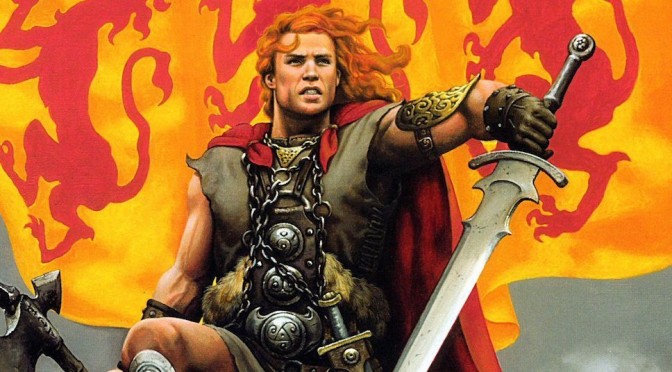An important part of John Stanley’s life before he was made king of the Isle Of Mann was several periods of service in Ireland. This service is remarkable because the government of Ireland in late 14th century was usually reserved for a member of the royal family and often a prince of the blood.
Facing the Ocean
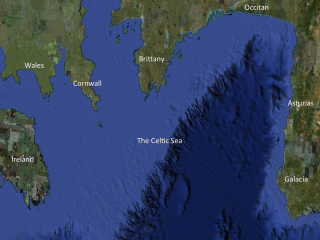 To understand the significance of these appointments it is necessary to take a brief look at Ireland’s history. The idea for this rather different view of Ireland’s position in Europe is borrowed from Barry Cunliffe’s book “facing the ocean” in which he makes a case that the western celts were a unified race along the Atlantic coast. In legend it was said that Ireland could be clearly seen from Galacia, now Northern Spain.
To understand the significance of these appointments it is necessary to take a brief look at Ireland’s history. The idea for this rather different view of Ireland’s position in Europe is borrowed from Barry Cunliffe’s book “facing the ocean” in which he makes a case that the western celts were a unified race along the Atlantic coast. In legend it was said that Ireland could be clearly seen from Galacia, now Northern Spain.
Kingdoms of Ireland
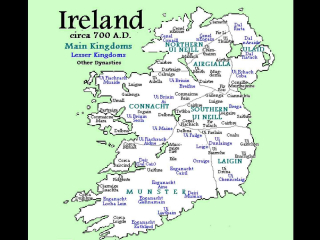 Ireland itself was divided into kingdoms, based on a clan structure. Not only the names of the kingdoms and the clans has been preserved but also the names of the rulers. In addition there was the position of “High King”, responsible for governance of the whole island. If Barry Cunliffe’s ideas are taken to the extreme Perhaps the High Kings held sway over a much wider area.
Ireland itself was divided into kingdoms, based on a clan structure. Not only the names of the kingdoms and the clans has been preserved but also the names of the rulers. In addition there was the position of “High King”, responsible for governance of the whole island. If Barry Cunliffe’s ideas are taken to the extreme Perhaps the High Kings held sway over a much wider area.
The High Kings
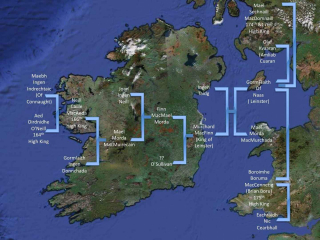 The genealogy of the Irish kings is well documented, leaading up to the traumatic events surrounding Brian Boru’s emengence as High King.
The genealogy of the Irish kings is well documented, leaading up to the traumatic events surrounding Brian Boru’s emengence as High King.The position of high king was essentially elective and the kings of the individual nations acknowledged the aspirant high kings superiority. Such a system was almost bound to lead to conflict and Brian Boru’s wife Gormflaith of Naas exacerbated the situation by marrying both of the major contenders as well as a Viking invader.
Governance by Rome
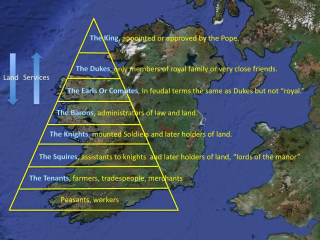 This system of governance was in any case different to the feudal system imposed in the rest of Europe. in the feudal system the king owned everything and permitted use of land to his close family and supporters.
This system of governance was in any case different to the feudal system imposed in the rest of Europe. in the feudal system the king owned everything and permitted use of land to his close family and supporters.
Each holder of a royal licence could then sub let to their own supporters in return for a variety of services and responsibilities.
Vestiges of this system still existed in the 1980’s in England where land could be “sold’ on a leasehold sometimes as short as 99 years. The land and all developments on it reverted to the real owner at the end of 99 years.
The Celtic system
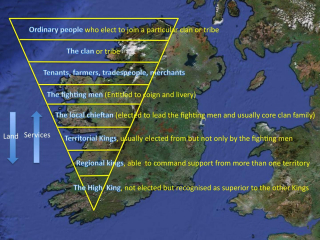 The celtic system was completely different. The land belonged to the clan and it was possible for ordinary people to elect to join a different clan if they were acceptable to that clan.
The celtic system was completely different. The land belonged to the clan and it was possible for ordinary people to elect to join a different clan if they were acceptable to that clan.
The clan decided how the land and the products of the land would be used and allocated responsibility to individuals to perform the work.
A separate group were the fighting men, though when under threat the whole clan could be mobilised.
The selection of the leaders of the fighting men was by election and the elective process extended to the appointment of Kings and the eventual selection of the High King.
The kings were given the responsibility to promote the interests of the clan. They were the servants, not the masters of the clan.
Brian Boru
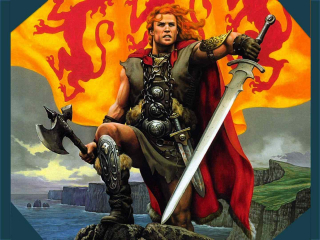 This is not to say that there were no attempts to take advantage of this situation by kings who wished to exert control. Brian Boru is considered to be a legendary hero,liberating the Irish people from the Viking threat, but in fact the bloody battle of Clontarf in 1014 was the result of his attempt to create an hereditary autocracy encompassing the whole island.
This is not to say that there were no attempts to take advantage of this situation by kings who wished to exert control. Brian Boru is considered to be a legendary hero,liberating the Irish people from the Viking threat, but in fact the bloody battle of Clontarf in 1014 was the result of his attempt to create an hereditary autocracy encompassing the whole island.
Clontarf
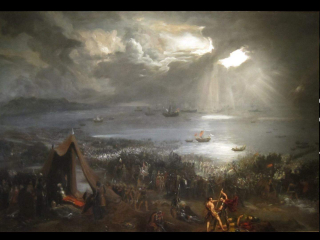 At Clontarf, Vikings fought on both sides. Significantly Brian Boru’s opponent Morda mac Murchada recruited Vikings from the orkneys and the Isle of Mann to join his army.
At Clontarf, Vikings fought on both sides. Significantly Brian Boru’s opponent Morda mac Murchada recruited Vikings from the orkneys and the Isle of Mann to join his army.
Legend tells us that it was the Manx King, Brodir, who killed Brian Boru.
The Normans
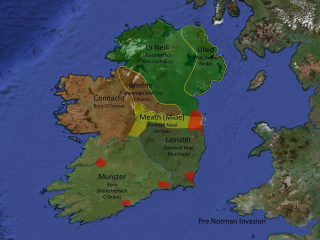 The scene was now set for the various aspirants who wished to become high kings to seek assistance from abroad and in in 1169 willing assistance was given to Diamait Mac Murcharda, by Henry II, King of England. Yes, this was the same family continuing to seek assistance from abroad!
The scene was now set for the various aspirants who wished to become high kings to seek assistance from abroad and in in 1169 willing assistance was given to Diamait Mac Murcharda, by Henry II, King of England. Yes, this was the same family continuing to seek assistance from abroad!
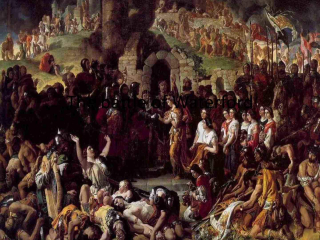 The tragedy of Ireland is that the Norman invasion of Ireland was badly co-ordinated and controlled. In England the normans, under William of Bayeux had extended their rule to the whole of the country within a year. At first it seemed that the same process would be continued with the battle of Wrexford serving a warning of the Norman’s intent. In 1171 Henry II went personally to Ireland to consolidate the invasion and to receive the homage of the Irish kings.
The tragedy of Ireland is that the Norman invasion of Ireland was badly co-ordinated and controlled. In England the normans, under William of Bayeux had extended their rule to the whole of the country within a year. At first it seemed that the same process would be continued with the battle of Wrexford serving a warning of the Norman’s intent. In 1171 Henry II went personally to Ireland to consolidate the invasion and to receive the homage of the Irish kings.
The papal involvement
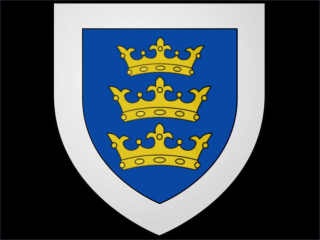 There were however other forces at work. The Pope had given William the Conqueror his approval not as King of England but as king of the British Isles and charged him with eliminating the “heresy “of Celtic Christianity. This is what became the imperative for campaigns in Scotland and Wales which though they were only partly successful, did show that the effort was being made.
There were however other forces at work. The Pope had given William the Conqueror his approval not as King of England but as king of the British Isles and charged him with eliminating the “heresy “of Celtic Christianity. This is what became the imperative for campaigns in Scotland and Wales which though they were only partly successful, did show that the effort was being made.
Ireland remained untouched. in 1155 Pope Adrian issued a bull requiring Henry II to eliminate the “filthy practices” to be found on the island. The blazon adopted for the Lord Lieutenant of Ireland shows the importance of the religious aspect of the invasion.
The Papal Arms
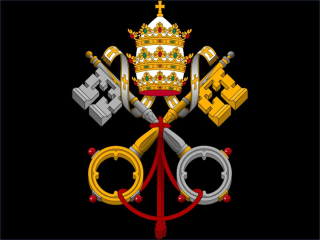 Compare it with the three crowns of the papal arms.
Compare it with the three crowns of the papal arms.
No compatibility
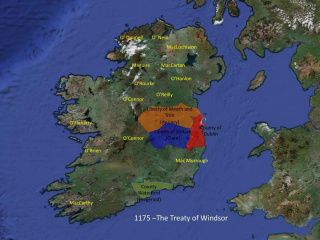 Unfortunately Henry the II and his son John were both distracted by the break up of their empire in what is now Northern France. The Norman’s in Ireland saw the opportunity to set up their own private kingdoms, intermarried with the irish clans and many of them were absorbed into the Irish Culture, becoming competitors to become High King.
Unfortunately Henry the II and his son John were both distracted by the break up of their empire in what is now Northern France. The Norman’s in Ireland saw the opportunity to set up their own private kingdoms, intermarried with the irish clans and many of them were absorbed into the Irish Culture, becoming competitors to become High King.
In England by 1200, even though the Anglo Saxons were dispossessed, the internal wars had ceased, there was no meaningful opposition to Henry II. In Ireland,sadly, there was no such stability.
The treaty of Windsor limited the Norman Lords to Leinster,Meath,Dublin and county Waterford and left Rory O’Conner(Ruaidri Ua Conchobair) as High King for the remainder.
Like almost everything to do with relations between England and Ireland there was a gross misunderstanding of what the treaty meant. Rory thought the treaty confirmed him as High King. Henry however considered the treaty confirmed Rory as his feudal vassal, a concept incomprehensible to Rory. In these circumstances Norman knights continued to carve out new territories for themselves and acquired ambitions to self government.
The Lords Lieutenants
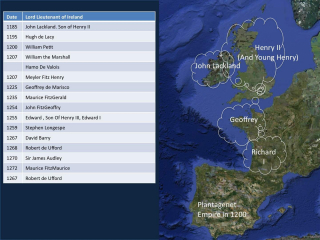 The Kings of England tried to keep control by the appointment of Lord Lieutenants and those holding this office included the son of Henry II, the future King John and the son of Henry III the future King Edward I
The Kings of England tried to keep control by the appointment of Lord Lieutenants and those holding this office included the son of Henry II, the future King John and the son of Henry III the future King Edward I
A patchwork of Kingdoms
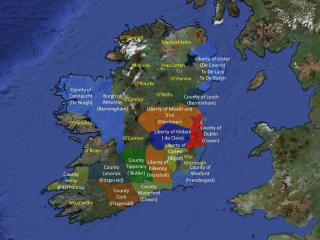 The efforts of the Lords Lieutenants were largely ineffective. Ireland was soon a patchwork quilt of new, essentially feudal kingdoms, imposed over the top of the still existing celtic culture. As time passed, many of the Norman’s in Ireland began to see themselves as something other than Norman or English.
The efforts of the Lords Lieutenants were largely ineffective. Ireland was soon a patchwork quilt of new, essentially feudal kingdoms, imposed over the top of the still existing celtic culture. As time passed, many of the Norman’s in Ireland began to see themselves as something other than Norman or English.
The Pale
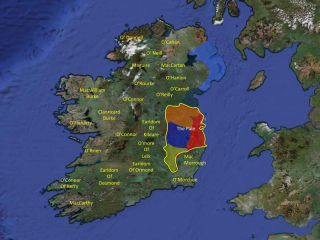 In time direct control from England was limited to an area around Dublin, known as “The Pale”. Norman knights outside this area were self governing and were referred to as being “beyond the pale”, a term which is used to this day to describe someone who is politically incorrect.
In time direct control from England was limited to an area around Dublin, known as “The Pale”. Norman knights outside this area were self governing and were referred to as being “beyond the pale”, a term which is used to this day to describe someone who is politically incorrect.
The Bruce Brothers
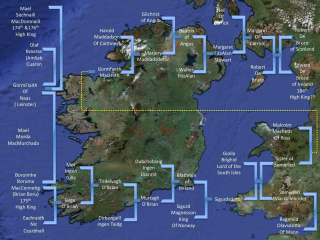 Another complication arose in that because of the intermarriages there were those outside of Ireland who were descended from the High Kings. Perhaps the best known example of this is the Bruce brothers. Robert went on to become king of Scotland and Edmund set out to repeat the feat in Ireland. The brothers also possessed high ranking Norman blood, which made them acceptable to their Norman contemporaries.
Another complication arose in that because of the intermarriages there were those outside of Ireland who were descended from the High Kings. Perhaps the best known example of this is the Bruce brothers. Robert went on to become king of Scotland and Edmund set out to repeat the feat in Ireland. The brothers also possessed high ranking Norman blood, which made them acceptable to their Norman contemporaries.
Edward de Bruce invaded Ireland in 1315 and obtained support from both Celts and Norman Irish as the new (184th) High King.
Athenry
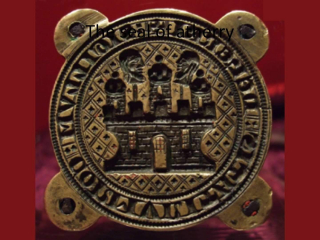 He and his allies were, however, defeated at Athenry in 1316 which probably ended any realistic ambitions he had to claim the position of high king two years later he was defeated and killed at Faughart.
He and his allies were, however, defeated at Athenry in 1316 which probably ended any realistic ambitions he had to claim the position of high king two years later he was defeated and killed at Faughart.
The defeat at Athenry has descended into legend as the most significant defeat of heroic celtic warriors struggling for independance against the English and as such has become through the song “fields of Athenry” become an anthem for many Irish sports teams as well as Glasgow Celtic.
The associated legend ignores two important facts – that the Celts were fighting to support a foreigner from Scotland – and that the victorious army was not English but a mixture of Irish Celts and Irish Normans. By that stage it was becoming difficult to distinguish the differences between these two groups.
Ineffective Lord Lieutenants
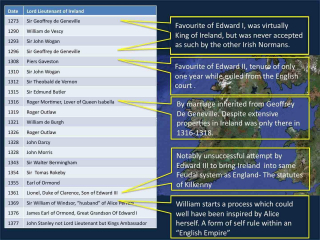 In the next hundred years the situation in Ireland spiralled out of control the Norman Irish grew more powerful and resorted to fighting amongst themselves. Many of the clans such as the O’Carrols, O’Conners and O’Brians retained their independance and had a sustantial influence with the Irish Normans if only because they were a continuing threat. The lord lieutenants failed to keep control. Both Piers Gaveston and Roger Mortimer clearly would rather have been somewhere else.
In the next hundred years the situation in Ireland spiralled out of control the Norman Irish grew more powerful and resorted to fighting amongst themselves. Many of the clans such as the O’Carrols, O’Conners and O’Brians retained their independance and had a sustantial influence with the Irish Normans if only because they were a continuing threat. The lord lieutenants failed to keep control. Both Piers Gaveston and Roger Mortimer clearly would rather have been somewhere else.
Roger Mortimer
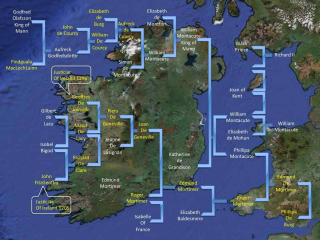 Geoffrey de Geneville and Roger Mortimer were both lord lieuotenants in this critical period. By marrying De Geneville’s daughter Mortimer inherited De Genevilles irish estates and held the post of Lord Lieutenant from 1316-1318.
Geoffrey de Geneville and Roger Mortimer were both lord lieuotenants in this critical period. By marrying De Geneville’s daughter Mortimer inherited De Genevilles irish estates and held the post of Lord Lieutenant from 1316-1318.
His appointment coincided exactly with the defeat of Edward de Bruce and therefore it was Mortimer planned for that defeat. part of Mortimer’s victory incuded the separation of the Norman Irish De Lacy family from the forces of De Bruce. Thirteen De Lacy’s were tried for treason. Such a strong man and capable military leader could have given much needed stability to Ireland but he left for England where he became the lover of Isabelle of France and after murdering Edward II the de facto king of England.
Lionel of Antwerp
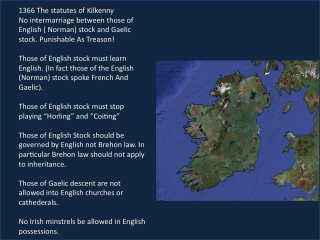 In exasperation Edward III, sent his son Lionel of Antwerp to impose change in Ireland. The infamous statutes of Kilkenny show that Lionel saw a necessary part of the solution to be separating the Norman Irish from the Celts. The Norman Irish at least understood the concepts of feudalism and had shown willingness to conform to strong leadership, whereas the Celtic clans clearly did not.
In exasperation Edward III, sent his son Lionel of Antwerp to impose change in Ireland. The infamous statutes of Kilkenny show that Lionel saw a necessary part of the solution to be separating the Norman Irish from the Celts. The Norman Irish at least understood the concepts of feudalism and had shown willingness to conform to strong leadership, whereas the Celtic clans clearly did not.
Presumably if the separation had been successful there would have been a concerted effort to conquer the whole island. We will never know as the statutes failed to find acceptance.
The Norman Irish now considered themselves more Irish than English. Many of them however had extensive estates in England, Wales and Scotland and therefore found it difficult to declare themselves independent.
The Mortimer succession
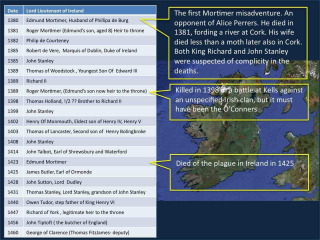 One of the mysteries of the medieval world is that although Edward III executed Roger Mortimer, either as the murderer of his father or for attempting to seize the throne, he quickly returned the Mortimer lands to Roger’s son Edmund.
One of the mysteries of the medieval world is that although Edward III executed Roger Mortimer, either as the murderer of his father or for attempting to seize the throne, he quickly returned the Mortimer lands to Roger’s son Edmund.
He then permitted, or perhaps even arranged for Edmund to marry his granddaughter Phillipa thus making their children second in line to the throne (after Richard II). Edmund also became Lord Lieutenant or Ireland but with unfortunate results. he died, whilst in the company of John Stanley, fording a river in Cork.
In 1377,upon the death of Edward III, Richard II became king and Edmund’s son Roger became heir to the throne.
Richard failed to produce an heir but Roger was killed at the Battle of Kells in 1398. Thus his son Edmund became heir to the throne.
In 1400 Henry IV siezed the throne and murdered Richard II thereby disinheriting Edmund who nevertheless became a third generation Lord lieutenant of Ireland.
Edmund died in 1423, supposedly of the plague but in the circumstances, one does wonder!
This left his daughter Anne as the legitimate heir to the throne of England. She married Richard of Conisborough who also had a claim to the throne as a grandson of Edward III. From this marriage came the Yorkist claim to the throne of England which, in turn, led to the wars of the roses.
The long involvement of the Mortimer family resulted in the Norman Irish supporting the Yorkist cause through the Wars of the Roses and beyond.
John Stanley
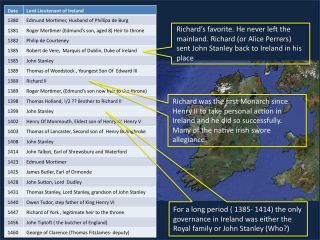 In the period between 1385 and 1414 Ireland was governed either by a member of the Royal family or by John Stanley. Does this mean there was a way in which he was related to the royal family, or was there some other reason?
In the period between 1385 and 1414 Ireland was governed either by a member of the Royal family or by John Stanley. Does this mean there was a way in which he was related to the royal family, or was there some other reason?
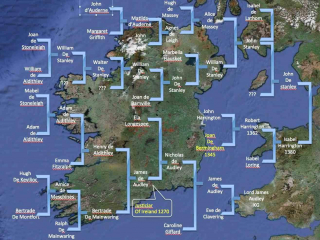 Conventional genealogy tells us the answer must be no. His Distant cousin Lord James Audley, was however descended from Henry II through an illegitimate son William Longespee.
Conventional genealogy tells us the answer must be no. His Distant cousin Lord James Audley, was however descended from Henry II through an illegitimate son William Longespee.
Examination of John’s family tree does however indicate a connection with Ireland. His son’s wife Isabel Harrington was a descendant of the Bermingham’s, lords of Athenry who orchestrated the demise of Edmund de Bruce. That gives an idea of where john’s power base in Ireland might have lay.
The de Bermingham’s
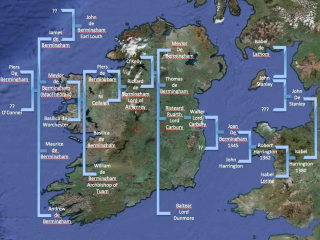 A further examination of the relevant branch of the Berminham family shows that they frequently intermarried with celtiv families and specifically with the daughters of regional kings. it is not entirely surprising therefore that John’s grandson who possessed this Irish heritage should have also been made Lord Lieutenant of Ireland but john himself possessed no Royal or Irish links.
A further examination of the relevant branch of the Berminham family shows that they frequently intermarried with celtiv families and specifically with the daughters of regional kings. it is not entirely surprising therefore that John’s grandson who possessed this Irish heritage should have also been made Lord Lieutenant of Ireland but john himself possessed no Royal or Irish links.
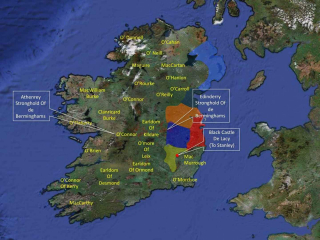 At the time John Stanley was serving in Ireland the English influence was limited to the east coast but families like the Berminghams had strongholds further to the west, where they coexisted, occasionally peaceably, with the celtic clans.
At the time John Stanley was serving in Ireland the English influence was limited to the east coast but families like the Berminghams had strongholds further to the west, where they coexisted, occasionally peaceably, with the celtic clans.
Black Castle
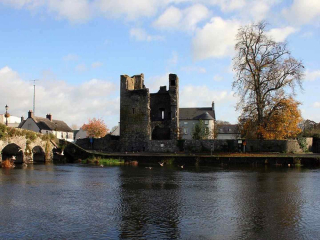 It is interesting to see the facilities mad available to John Stanley. Black Castle was originally built by the De Lacy family but after their demise in 1318 it was confiscated remaining part of the royal estates until given to John Stanley in 1377. In 1402 Heny IV having dealt with unrest in England, caused by the deposition and murder of Richard II, sent his heir Henry of Monmouth to take over from John Stanley in Ireland. He then sent his younger son Thomas of Lancaster.
It is interesting to see the facilities mad available to John Stanley. Black Castle was originally built by the De Lacy family but after their demise in 1318 it was confiscated remaining part of the royal estates until given to John Stanley in 1377. In 1402 Heny IV having dealt with unrest in England, caused by the deposition and murder of Richard II, sent his heir Henry of Monmouth to take over from John Stanley in Ireland. He then sent his younger son Thomas of Lancaster.
There seems to have been a concern that John Stanley himself was pursuing a policy which might result in independence for Ireland and that John Stanley had ambitions to play a leading part in the new administration.
By sending both his sons to Ireland Henry IV was forceably reminding the Irish, and perhaps John, where their loyalties should lie.
In the meantime two successive kings of the Isle of Mann, William le Scope and Thomas Percy revolted against Henry IV’s rule. in 1406 Henry allowed John Stanley to become king of an independent Mann but within a commonwealth of which he was head. After this appointment John was allowed to return to Ireland and again take control of the government.
Was his role in the Isle of Mann supposed to be a model for Ireland? Perhaps it was! Sadly for Ireland it never came to fruition.
When Henry of Monmouth came to the throne in 1413 as Henry V he switched his attention to the remnants of the English Empire in France. Ireland was left to it’s fate. John Stanley died in Ireland twelve months later.
